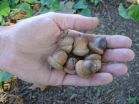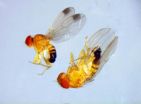(Press-News.org) Widely used antibiotics may increase incidence and severity of allergic asthma in early life, according to a University of British Columbia study.
The study, published today in the journal EMBO reports, shows that certain antibiotics that affect intestinal bacteria also had a profound impact on allergic asthma.
"It has long been suspected that kids exposed to more antibiotics – like those in developed countries – are more prone to allergic asthma," says the study's author, UBC microbiologist Brett Finlay. "Our study is the first experimental proof that shows how."
Finlay's team at UBC's Dept. of Microbiology and Immunology and Michael Smith Laboratories examined how two widely used antibiotics – streptomycin and vancomycin – affected the bacterial "ecosystem" in the gut. They found that vancomycin profoundly alters the bacterial communities in the intestine and increases severity of asthma in mouse models.
The same antibiotics do not impact adult mice's susceptibility to asthma, indicating that early life is a critical period of establishing a healthy immune system.
Allergic asthma affects more than 100 million people worldwide and its prevalence is increasing on average by 50 per cent every decade, particularly among children in industrialized countries. According to the Asthma Society of Canada, asthma affects at least 12 per cent of Canadian children.
The human gut is colonized by approximately 100 trillion bacteria, and contains upwards of 1,000 bacterial species. While not fully understood, these micro-organisms, known as "gut flora," perform a host of useful functions, says Finlay.
"Modern societal practices, such as improved sanitation methods and widespread antibiotic use, are causing the disappearance of ancestral species of bacteria in our gut that may be critical to a healthy immune system," says Finlay.
"Our study shows this is the case with certain antibiotics and allergic asthma, and the gut-lung connection is also consistent with observations that incidence of asthma has not increased significantly in developing countries where antibiotic use is less prevalent – and in turn, the gut flora is permitted to fully develop."
The study is funded by the Canadian Institutes of Health Research (CIHR) through the Canadian Microbiome Initiative, in partnership with Genome BC and the Allergy, Genes and Environment Network (AllerGen NCE).
Marc Ouellette, Scientific Director of CIHR's Institute of Infection and Immunity, noted the importance of the team's results: "It has been recognized that microbes play an important role in human health – and we are discovering that a disruption of these bugs is associated with a number of chronic health conditions. The important results from Prof. Finlay's team confirm that giving antibiotics to young children, which disturb their normal bacterial flora, should not be taken lightly."
### The Canadian Institutes of Health Research (CIHR) is the Government of Canada's health research investment agency. CIHR's mission is to create new scientific knowledge and to enable its translation into improved health, more effective health services and products, and a strengthened Canadian health care system. Composed of 13 Institutes, CIHR provides leadership and support to more than 14,100 health researchers and trainees across Canada.
Exposure to antibiotics linked to severity of allergic asthma: UBC research
2012-03-19
ELSE PRESS RELEASES FROM THIS DATE:
'Belfast Summit important in preventing Cyber World War' -- Eugene Kaspersky
2012-03-19
One of the world's leading Internet security experts, Eugene Kaspersky, has described the World Cyber Security Technology Research Summit at Queen's University Belfast as key in preventing a Cyber World War.
Eugene Kaspersky, CEO and co-founder of the largest antivirus company in Europe, Kaspersky Lab, will be giving a keynote address at the second annual Cyber Security Technology Research Summit on Friday 16 March.
The cyber security guru is joining some of the world's leading cyber security experts and government policy makers from around the world for a two-day meeting ...
Cell-signaling pathway has key role in development of gestational diabetes, says Pitt team
2012-03-19
PITTSBURGH, March 16 – Researchers at the University of Pittsburgh School of Medicine have identified a cell-signaling pathway that plays a key role in increasing insulin secretion during pregnancy and, when blocked, leads to the development of gestational diabetes. Their findings are available online today in Diabetes, one of the journals of the American Diabetes Association.
During pregnancy, pancreatic beta cells should expand and produce more insulin to adapt to the needs of the growing baby, explained senior investigator Adolfo Garcia-Ocana, Ph.D., associate professor ...
Meeting greater number of recommended cardiovascular health factors linked with lower risk of death
2012-03-19
CHICAGO – In a study that included a nationally representative sample of nearly 45,000 adults, participants who met more of seven recommended cardiovascular health behaviors or factors (such as not smoking, having normal cholesterol levels, eating a healthy diet), had a lower risk of death compared to participants who met fewer factors, although only a low percentage of adults met all seven factors, according to a study appearing in JAMA. The study is being published early online to coincide with its presentation at a specialty meeting of the American Heart Association.
"Cardiovascular ...
Lyme disease surge predicted for the northeastern US
2012-03-19
The northeastern U.S. should prepare for a surge in Lyme disease this spring. And we can blame fluctuations in acorns and mouse populations, not the mild winter. So reports Dr. Richard S. Ostfeld, a disease ecologist at the Cary Institute of Ecosystem Studies in Millbrook, NY.
What do acorns have to do with illness? Acorn crops vary from year-to-year, with boom-and-bust cycles influencing the winter survival and breeding success of white-footed mice. These small mammals pack a one-two punch: they are preferred hosts for black-legged ticks and they are very effective ...
Nano rescues skin
2012-03-19
Nanoparticles containing chitosan have been shown to have effective antimicrobial activity against Staphylococcus saprophyticus and Escherichia coli. The materials could be used as a protective wound-healing material to avoid opportunistic infection as well as working to facilitate wound healing.
Chitosan is a natural, non-toxic and biodegradable, polysaccharide readily obtained from chitin, the main component of the shells of shrimp, lobster and the beak of the octopus and squid. Its antimicrobial activity is well known and has been exploited in dentistry to prevent ...
Novel plastics and textiles from waste with the use of microbes
2012-03-19
New biotechnological and chemical methods will facilitate efficient production of chemicals, materials and fuels from renewable natural resources. The Academy of Finland Centre of Excellence (CoE) in White Biotechnology – Green Chemistry Research focuses on the research and development of microbial cells, or cell factories, for producing new useful compounds from sugars in plant biomass. These compounds can be used, for example, for manufacturing bioplastics or in medical applications.
"By means of gene technology, we can modify microbial metabolism and thereby produce ...
An invasive Asian fly is taking over European fruit
2012-03-19
Coming from the Asian continent, Drosophila suzukii has only been in Spain for a short time. Far away from slipping through into the Iberian Peninsula, it accelerated towards the north of Europe where it has already crossed the Alps. Amongst its preferred target are cherries and red fruits but any type of fruit is suitable for it to lay its eggs. This insect is posing a threat to the fruit of more and more European countries.
"Out of the 3,000 known species of Drosophilae, commonly named the vinegar fly, only two are potentially dangerous to fruit crops. One of them is ...
Survival of the fittest -- ESF hosts session on the challenges of life in extreme environments
2012-03-19
Have you ever wondered how life is sustained in environments like deserts, deep seas or the polar regions? How do organisms adapt and thrive in such harsh conditions, and what challenges do they face as a result of human activities and climate change, especially climate "extremization"? Shedding light on some of these issues is the objective of the European Science Foundation's (ESF) session on 27 March at Planet Under Pressure 2012. The session will look at different aspects of life in extreme environments - from knowledge to sustainable exploitation of new resources under ...
Treating psoriasis to prevent heart attacks and strokes
2012-03-19
Montreal, March 16, 2012 – A clinical study co-led by the Montreal Heart Institute and Innovaderm Research Inc., which was presented today at the annual meeting of the American Academy of Dermatology, shows that a new treatment for psoriasis could be associated with a significant decrease in vascular inflammation, a major risk factor of cardiovascular disease.
Psoriasis is a chronic inflammatory disease of the skin and joints that affects up to 3% of the population. This disease is associated with a greater risk of heart attack (infarction) and stroke. The goal of this ...
Early spring drives butterfly population declines
2012-03-19
Early snowmelt caused by climate change in the Colorado Rocky Mountains snowballs into two chains of events: a decrease in the number of flowers, which, in turn, decreases available nectar. The result is decline in a population of the Mormon Fritillary butterfly, Speyeria mormonia.
Using long-term data on date of snowmelt, butterfly population sizes and flower numbers at the Rocky Mountain Biological Laboratory, Carol Boggs, a biologist at Stanford University, and colleagues uncovered multiple effects of early snowmelt on the growth rate of an insect population.
"Predicting ...


